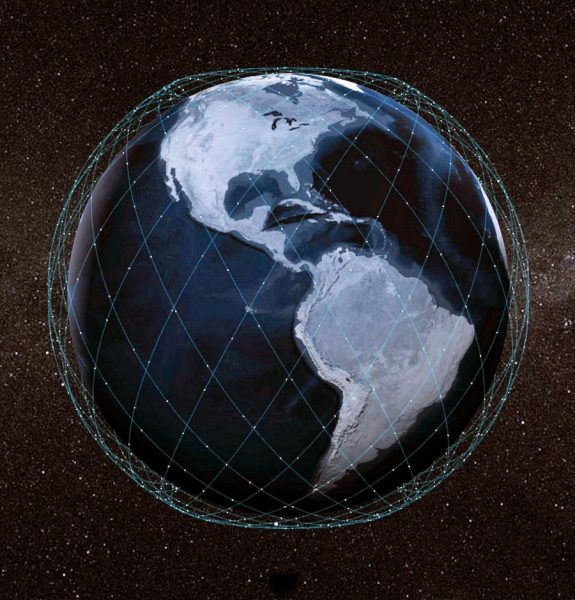Starlink Details Data Speed of its Space-based 4G Mobile Network

A few months ago Starlink (SpaceX) announced (here) that it had teamed-up with T-Mobile to launch a new global space-based 4G and 5G mobile network, which would be supported by the former company’s mega-constellation of Low Earth Orbit (LEO) based broadband satellites. More details on the network have now been revealed.
The Starlink network currently has around 3,270 LEO satellites in a low orbit around the Earth (altitude of c. 550 kilometres) and their initial plan is to deploy a total of 4,425 by 2024. Residential customers in the UK normally pay from £75 per month and £460 for the regular home kit (standard dish, router etc.).
However, the new agreement with T-Mobile goes much further, by enabling even regular Smartphones to connect with Starlink’s LEOs using familiar mid-band spectrum for 4G and 5G connections. Under the Coverage Above and Beyond (satellite-to-cellular) solution, both companies initially plan to offer “text coverage” (i.e. SMS, MMS and “participating messaging apps“) – starting in the continental US, Hawaii, parts of Alaska, Puerto Rico and territorial waters.
Advertisement
The first beta services are due to go live in select areas by the end of 2023, which would later be followed by the addition of voice and data (mobile broadband) connectivity on their second generation (V2 or GEN2 if you prefer) satellites. The attraction of all this is obvious, since it could potentially create a simple solution to the otherwise patchy, tedious and costly problem of global roaming (assuming regulators in each country are receptive and ground stations exist etc.).
At the time, SpaceX didn’t reveal a lot about the technical and network setup of all this, except that it would initially use a small slice of their network capacity across a given coverage area (i.e. “2 to 4 Mbits per cell zone“). But we just got some additional details as part of the company’s recent and successful FCC application to deploy a further 7,500 GEN2 Starlink satellites.
The documents reveal that Starlink’s new “direct-to-cell” system will be able to provide voice, messaging and basic website browsing at “theoretical peak speeds of up to either” 3Mbps or 7.2Mbps peak upload (Earth-to-Space) over 1.4MHz or 5MHz bandwidth channels per beam, respectively, and up to either 4.4Mbps or 18.3Mbps on the downlink (Space-to-Earth) over the same bandwidth channels per beam using LTE (4G) technology.
Elon Musk said:
“Important to note that this is *total* bandwidth within a cell, so would be divided among all phones. Starlink will be great for text messages, voice calls & low resolution pictures. If only a dozen phones are active, which is true in remote regions, then video will work.
But the really mind-blowing thing is that this means your phone will work anywhere on Earth, unless blocked by local government!”
The system would be rolled out across a payload deployed on a sub-set of 2,016 GEN2 satellites. Once fully deployed, this would enable SpaceX/Starlink to have full and continuous coverage of the Earth within +58 degrees to -58 degrees latitude by mid-2024.
Advertisement
However, there’s still a question mark over how much T-Mobile will charge for this service. The operator has said that the feature may be included for free on their most popular plans, but others might need to pay a small charge for an add-on (not unlike adding roaming support to your plan, albeit a potentially very powerful form of roaming).
Mark is a professional technology writer, IT consultant and computer engineer from Dorset (England), he also founded ISPreview in 1999 and enjoys analysing the latest telecoms and broadband developments. Find me on X (Twitter), Mastodon, Facebook, BlueSky, Threads.net and Linkedin.
« OneWeb and SpaceX Successfully Launch 40 LEO Broadband Satellites






















































Will normal phones work or only new phones with new capabilities?
it says “regular phones” in the article, I assume this means existing ones.
“by enabling even regular Smartphones to connect with Starlink’s LEOs using familiar mid-band spectrum”.
I don’t get how it will work though (not saying it won’t, but I don’t understand how). I thought you’d need significant wattage to send something to even an LEO satellite. As an example you need 5W to talk to the ISS on a HAM radio and mobiles peak at not even half that ~2W. I will hunt around for a whitepaper or something on it.
I’m baffled by this too, Starlink dishes use phased array beam-forming and consume considerable power.
Perhaps the low data rate is the key. Maybe they have some kind of low data rate sub noise floor modulation scheme with high redundancy.
iPhone 14 has Ana ability to talk to satellites to relay coordinates and basic text for emergency purposes but the user needs to point the phone at the sat and there is a special app that helps that happen.
https://support.apple.com/en-gb/HT213426
in 10 years its possible there won’t be fixed masts for phones and everything will be satellite based.
may need to start buying tin foil hats so I don’t get tracked going for a sneaky pint or visiting my @mate@
It just depends on the sensitivity of the antenna, the Starlink antenna will be large and sensitive enough to pick up the very weak phone signal and transmit back with enough power that the phone antenna can pick it up all ok, it will also do correction for the doppler effect too, to the phone it will seem like it’s connected to a regular Earth based mast
Similar how WiFi generally only has a range of 100m but with the right antenna you can pick up someone’s WiFi from a few KMs away
Could well be affected by some weather conditions though, I think it’s smart keeping it to text and messaging at the start as the bandwidth required for those is microscopic compared to voice and web browsing
They can’t even get a decent signal from the Cell tower a mile away and now they think it’s going to work from space, nice try guys…
Either they didn’t point any antennas in your direction/don’t have long range bands (b20, b28, b8) or there’s stuff between you and the mast. I used to get okay signal from a cell tower 1.5 miles away, but it was line of sight.
This satellite signal is only for basic service, not to be loading YouTube videos. Not sure why you think it doesn’t work when there’s nothing between you and the satellite (this is for outdoors coverage) and satellites will have big antennas to receive your phone’s signal.